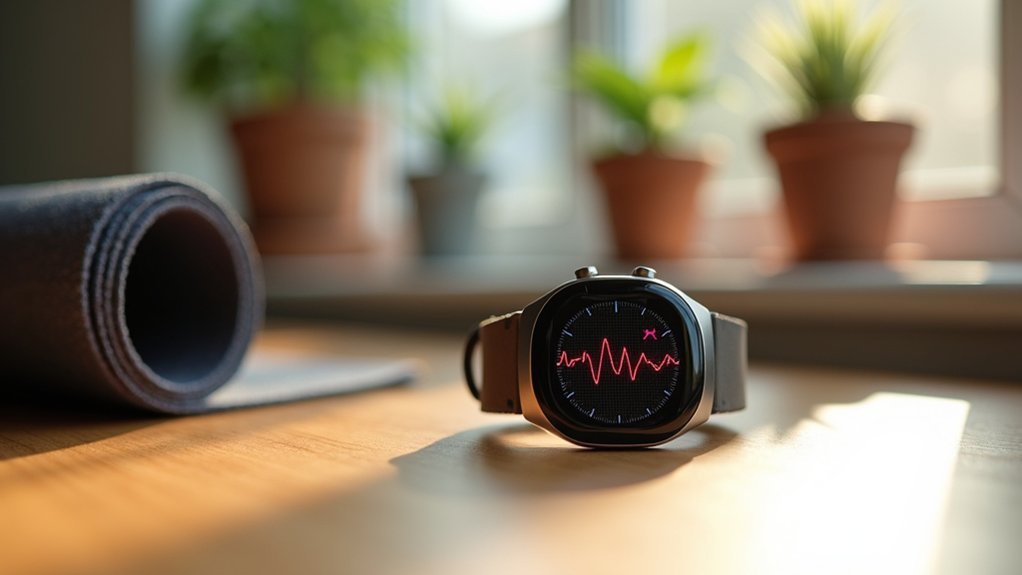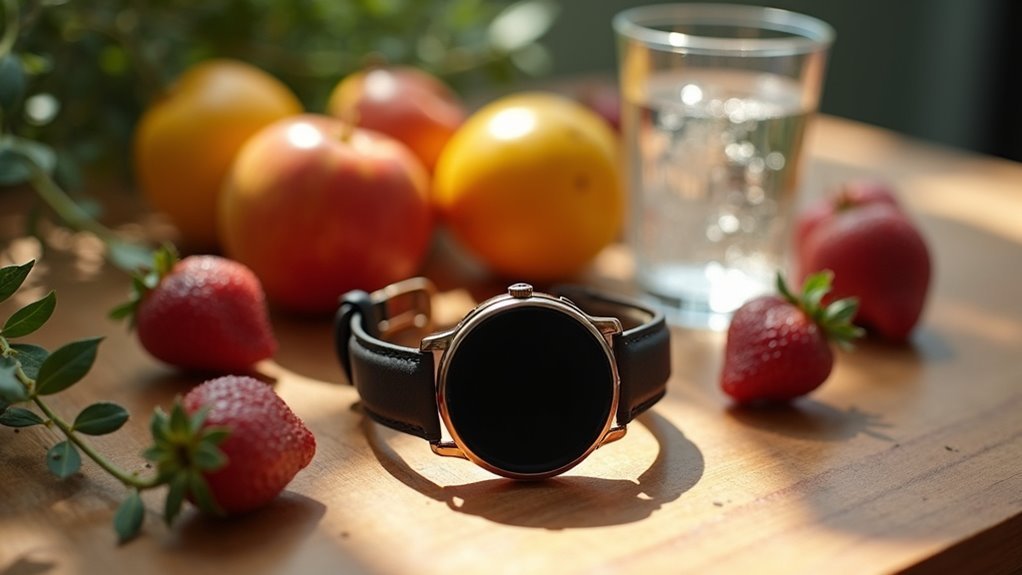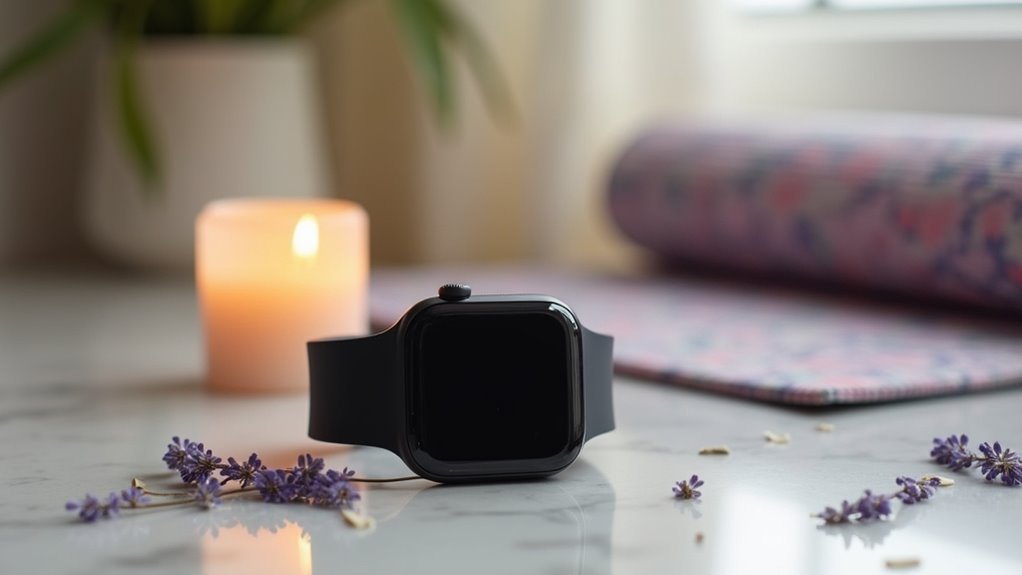To maximize your HRV tracking, you’ll need the right device—chest straps offer highest accuracy while rings excel at overnight monitoring. Maintain consistent daily habits like proper hydration, quality sleep, and stress management techniques. Collect data at the same time each morning in controlled conditions for reliable trends. Focus on RMSSD metrics and weekly averages rather than single readings. Finally, integrate your HRV data with training decisions to optimize performance and recovery based on your body’s physiological state.
Choose the Right HRV Monitoring Device for Your Needs
When selecting an HRV monitoring device, you’ll find three main categories that each offer distinct advantages depending on your tracking goals and lifestyle preferences.
Chest strap monitors like the Polar H10 deliver the highest accuracy through direct skin contact and minimal motion artifacts, making them ideal for clinical or professional athletic use.
Smartwatches and wrist-based devices offer convenience for 24/7 tracking, though Garmin watches tend to provide more consistent results than Apple Watch or Fitbit devices.
Ring-based monitors like the Oura Ring excel at overnight monitoring with superior comfort but may report inflated HRV values.
Consider your primary purpose—whether it’s athletic training, general wellness, or medical monitoring—alongside factors like battery life, app integration, and connectivity options when making your choice. Remember that HRV serves as a valuable indicator of autonomic regulation, helping you track physiological changes and improvements in your overall health and performance.
Optimize Your Daily Habits to Enhance HRV Accuracy
While having the right HRV monitoring device forms the foundation of accurate tracking, your daily habits play an equally essential role in obtaining reliable and meaningful measurements. Your lifestyle choices directly impact your autonomic nervous system, which determines HRV readings.
Proper hydration enhances blood volume and cardiovascular function, while dehydration elevates sympathetic activity and lowers HRV. You’ll need approximately one ounce of water per pound of body weight daily. Quality sleep supports recovery and measurement stability, so maintain consistent bedtimes and minimize screen exposure beforehand. Since circadian rhythm naturally influences HRV patterns throughout the day, taking measurements at the same time each morning helps establish reliable baseline readings.
| Habit Category | Daily Actions |
|---|---|
| Hydration | Track water intake, aim for 1oz per pound bodyweight |
| Sleep | Consistent bedtime, optimize sleep environment |
| Stress Management | Practice breathing techniques, mindfulness meditation |
| Nutrition | Avoid alcohol, eat anti-inflammatory foods consistently |
Master the Art of Consistent Data Collection
Three fundamental principles separate amateur HRV tracking from professional-grade data collection: timing consistency, environmental control, and measurement standardization.
You’ll achieve peak results by collecting data at the same time daily, eliminating variability from circadian rhythms and external factors.
Create controlled conditions by lying down in a quiet environment, minimizing distractions that introduce noise into your measurements. This relaxed state guarantees your autonomic nervous system isn’t influenced by external stimuli. Resting conditions in a supine position provide a reference for HRV analysis, while active orthostatic tests yield additional insights into autonomic regulation.
Standardize your measurement periods—whether you’re using short-term sessions under five minutes or longer protocols spanning hours. Consistency in duration enables accurate trend analysis over time.
Don’t overlook equipment maintenance. Regularly check your devices to guarantee accurate data capture, and establish secure, organized storage systems for future analysis and healthcare professional consultations.
Decode Your HRV Metrics and Trends Effectively
Understanding your HRV data transforms raw numbers into actionable insights about your body’s stress and recovery patterns. Focus on RMSSD, which reflects parasympathetic activity and ranges from 20-150 milliseconds depending on measurement methods.
Don’t chase universal ideal ranges—your baseline varies based on age, fitness level, and individual factors. Track daily patterns to identify trends rather than obsessing over single readings. High HRV indicates good adaptability between your nervous systems, while consistently low values may signal stress or poor recovery.
Use weekly and monthly averages to monitor long-term health changes, as seasonal variations naturally affect your measurements. Remember that sleep quality, exercise, emotional state, and environmental factors all influence your scores, so interpret data within context rather than isolation. Recognize that HRV data exhibits significant day-to-day variability, making it essential to focus on patterns rather than individual measurements.
Integrate HRV Data With Your Training and Recovery Protocol
Once you’ve established your personal HRV baseline and identified your smallest worthwhile change (SWC), you can transform this data into a powerful training compass that guides daily decisions about intensity, recovery, and performance optimization.
When your daily HRV falls within your SWC range, you’re ready for moderate to high-intensity sessions. However, if it drops outside this range, prioritize recovery activities like mobility work or complete rest.
Monitor HRV for 12-48 hours post-training to identify suppressed parasympathetic activity, indicating incomplete recovery. This prevents overuse injuries and overtraining by ensuring you don’t resume high-intensity work prematurely.
Combine HRV tracking with recovery technologies like PEMF therapy or NEUBIE treatments for enhanced autonomic rebalancing. HRV-guided training reduces the number of non-responders who fail to improve from their training programs.
This dynamic approach outperforms rigid training schedules by responding to your body’s actual physiological state.
Frequently Asked Questions
Can Medications Affect My Heart Rate Variability Readings?
Yes, medications can greatly affect your HRV readings. Beta-blockers, antidepressants, and hypertension medications alter measurements. You’ll need to consult your healthcare provider to understand how your specific medications impact your HRV data interpretation.
How Does Age Impact Normal HRV Ranges and Expectations?
Your HRV naturally decreases with age, dropping considerably from young adulthood through middle age. If you’re 20-25, expect 55-105 range; at 60-65, you’ll typically see 25-45 values.
Is It Safe to Track HRV During Pregnancy?
Yes, tracking HRV during pregnancy is safe using modern wearable devices. Studies confirm no adverse effects from continuous monitoring, and it’s actually beneficial for identifying cardiovascular risks and supporting thorough maternal health assessment.
Do Underlying Health Conditions Make HRV Tracking Unreliable?
Underlying health conditions can make your HRV tracking less reliable by reducing variability and causing inconsistent heart rhythms. You’ll need longer monitoring periods and should interpret results alongside your overall health status.
How Quickly Can Lifestyle Changes Improve My HRV Scores?
You’ll typically see initial HRV improvements within 2-4 weeks of consistent lifestyle changes. However, significant long-term benefits usually develop over several months to years with sustained healthy habits.





Leave a Reply